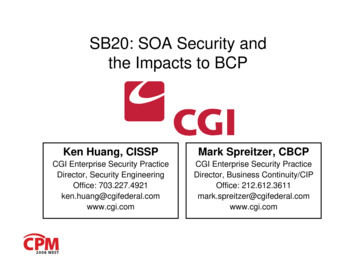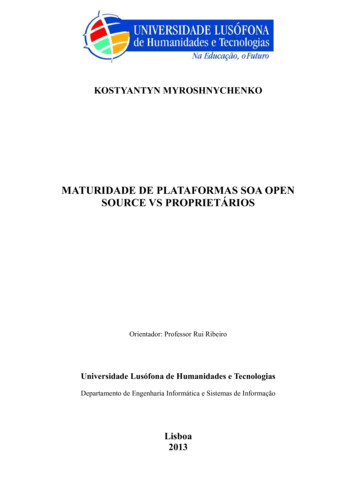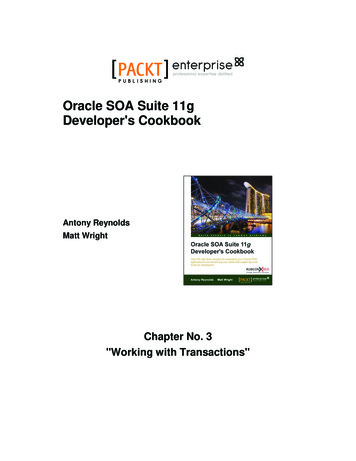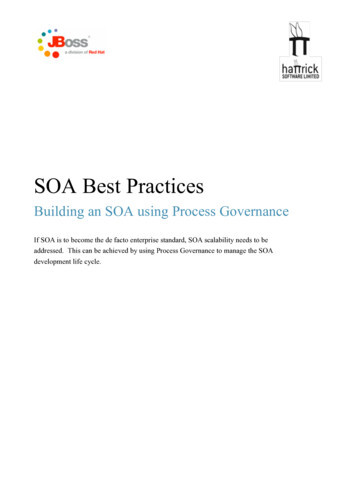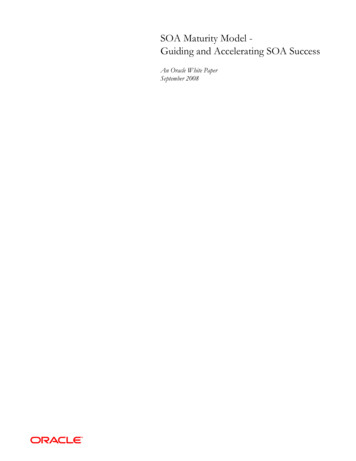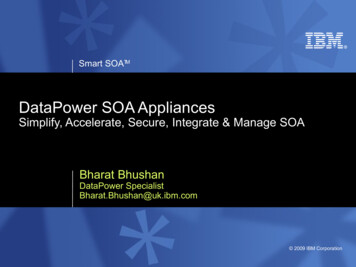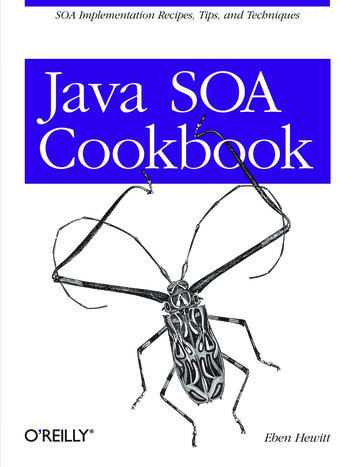
Transcription
Java SOA CookbookEben HewittBeijing Cambridge Farnham Köln Sebastopol Taipei Tokyo
Java SOA Cookbookby Eben HewittCopyright 2009 Eben Hewitt. All rights reserved.Printed in the United States of America.Published by O’Reilly Media, Inc., 1005 Gravenstein Highway North, Sebastopol, CA 95472.O’Reilly books may be purchased for educational, business, or sales promotional use. Online editionsare also available for most titles (http://safari.oreilly.com). For more information, contact our corporate/institutional sales department: (800) 998-9938 or corporate@oreilly.com.Editor: Simon St.LaurentProduction Editor: Loranah DimantCopyeditor: Emily QuillProofreader: Loranah DimantIndexer: Lucie HaskinsCover Designer: Karen MontgomeryInterior Designer: David FutatoIllustrator: Robert RomanoPrinting History:March 2009:First Edition.Nutshell Handbook, the Nutshell Handbook logo, and the O’Reilly logo are registered trademarks ofO’Reilly Media, Inc. Java SOA Cookbook, the image of a harlequin longhorn beetle on the cover, andrelated trade dress are trademarks of O’Reilly Media, Inc.Many of the designations used by manufacturers and sellers to distinguish their products are claimed astrademarks. Where those designations appear in this book, and O’Reilly Media, Inc. was aware of atrademark claim, the designations have been printed in caps or initial caps.While every precaution has been taken in the preparation of this book, the publisher and author assumeno responsibility for errors or omissions, or for damages resulting from the use of the information contained herein.TMThis book uses RepKover , a durable and flexible lay-flat binding.ISBN: 978-0-596-52072-4[M]1236962685
Table of ContentsPreface . . . . . . . . . . . . . . . . . . . . . . . . . . . . . . . . . . . . . . . . . . . . . . . . . . . . . . . . . . . . . . . . . . . . xiiiPart I. SOA Fundamentals1. Introduction to SOA . . . . . . . . . . . . . . . . . . . . . . . . . . . . . . . . . . . . . . . . . . . . . . . . . . . . . 31.11.21.31.41.51.61.71.81.9Defining a ServiceDefining SOAIdentifying Service CandidatesIdentifying Different Kinds of ServicesModeling ServicesMaking a Service ComposableSupporting Your SOA EffortsSelecting a Pilot ProjectEstablishing Governance49121618202330332. XML Schema and the SOA Data Model . . . . . . . . . . . . . . . . . . . . . . . . . . . . . . . . . . . . . .15Designing Schema for SOACreating Canonical Data ModelUsing Chameleon Namespace DesignVersioning SchemasReference SchemasCommon Schema TypesValidating an XML Document Against a SchemaValidating an XML Document Against Multiple SchemasRestricting Schema Types with Regular ExpressionsUsing Schema EnumerationsGenerating Java Classes from SchemaGenerating a Schema from JavaGenerating Java Source Files from XML Schema in AntGenerating an XML Document Instance from a SchemaCustomizing How a Java Class Is Generated from Schema414852545757616465676875808183v
2.16 Validating Against a Schema During Marshaling and Unmarshaling 882.17 Collecting Schema Validation Events During Marshaling andUnmarshaling913. Working with XML and Java . . . . . . . . . . . . . . . . . . . . . . . . . . . . . . . . . . . . . . . . . . . . . 953.13.23.33.43.53.63.73.83.93.103.113.12Reading an XML Data StreamWriting XML Data StreamsFiltering Data in an XML StreamSelecting Values from an XML DocumentUpdating a Value in an XML DocumentConverting a Java Object into an XML Document InstanceConverting an XML Document Instance into a Java ObjectGenerating a Schema from an XML DocumentConverting XML to Java Without JAXBCustomizing Code Generation in JAXBFinding the JAR That Contains a Given Class on LinuxTransparently Substituting XML Files96102104107112114118120122124125127Part II. Web Services4. Getting Started . . . . . . . . . . . . . . . . . . . . . . . . . . . . . . . . . . . . . . . . . . . . . . . . . . . . . . . 1334.14.24.34.44.54.64.74.84.94.10Using Publicly Available Web Services to Test AgainstInstalling MetroInstalling Oracle WebLogicCreating and Deploying the Simplest Web ServiceCreating and Deploying a Service to WebLogicSetting Up a Maven 2 Service and Client ProjectUnderstanding WSDLUsing References in NetBeans to Generate Web Service ClientsMonitoring SOAP Traffic with MetroMonitoring SOAP Traffic with TCPMon1341401431451471491551581611645. Web Services with SAAJ . . . . . . . . . . . . . . . . . . . . . . . . . . . . . . . . . . . . . . . . . . . . . . . . 1695.15.25.35.45.55.65.75.85.9Creating a SOAP Element with a Qualified NameCreating a Complete SOAP MessageWriting a SOAP Response to an Output StreamCreating a Web Service Client Based on an Existing SOAP EnvelopeExtracting Content from a SOAP MessageCreating a Web Service Client Using Raw XML Source and DOMAdding a MIME HeaderAdding Namespace DeclarationsSpecifying SOAPActionvi Table of Contents173175178180184186189189190
ding an Attribute to an ElementRemoving a Header from a SOAP MessageAdding Headers to a SOAP RequestAccessing All SOAP Header ElementsAdding an Attachment to an Outbound SOAP MessageAccessing Inbound Attachment DataConnecting to a SAAJ Endpoint Without a WSDLWorking with SOAP ActorsAsynchronous Invocation with DispatchValidating Your Payload Against a Schema on the ClientProviding a Web Service with SAAJSending and Receiving SOAP Faults1951971982062082092102112132142212266. Creating Web Service Applications with JAX-WS . . . . . . . . . . . . . . . . . . . . . . . . . . . . 6.156.166.176.186.19Calling a Web Service from the Command LineUsing JAX-WS Annotation Name PropertiesInvoking the Simplest Web ServiceCreating a Client ProxyConsuming a Web Service from a Servlet or EJBConsuming a Web Service from a JSPUsing a JAXB-Annotated Instance in a SOAP MessageUsing wsimport in a Maven ProjectDealing with Version Errors in wsgen and wsimportAdding Headers to a SOAP RequestIntercepting the Request to Perform Protocol-Specific WorkIntercepting the Request to Perform Work on Your PayloadSharing Data Between Handler InvocationsPassing Binary Data in a RequestUsing Binary Data in a SOAP MessageEnabling Binary Optimization on the ClientValidating a SOAP Payload Against a Schema with MetroMaking Asynchronous Calls with a JAX-WS ClientOverriding the Endpoint Address in an 02912943007. Providing SOAP-Based Web Services . . . . . . . . . . . . . . . . . . . . . . . . . . . . . . . . . . . . . 303Assembling a Service for DeploymentDetermining a Service Development ModelChoosing Encoding, Use, and Parameter StylesGenerating a WSDL and Portable Artifacts Based on a Java ServiceEndpoint Implementation7.5 Creating a Basic Web Service7.6 Specifying Namespaces7.7 Creating a Web Service Operation7.17.27.37.4304306314319324328328Table of Contents vii
7.217.227.237.24Specifying a Web Service Message PartSpecifying an Operation Return ValueDefining Zero-Argument OperationsDefining Operations with Void Return TypeCreating a Web Service That Uses Complex Types Based onCustom WSDL and a Custom SchemaSpecifying the SOAP Binding Style, Use, and Parameter StyleConfiguring Standard Custom BindingsExcluding a Public Method from a ServiceCreating a Service Provider with an XML ViewImplementing Server-Side Handler ChainsProviding Stateful ServicesAdding a Header with a Method ParameterAccessing Incoming Header Parameters in a ServiceProviding a Value for SOAP Action or WS-Addressing ActionOptimizing Transmission of Binary Content on the ServerGetting and Sharing Data About Users and the RequestUsing Header References with Holder T 38. RESTful Web Services . . . . . . . . . . . . . . . . . . . . . . . . . . . . . . . . . . . . . . . . . . . . . . . . . . 8.158.168.178.188.198.208.218.22Creating a POX over HTTP Service with ServletsA RESTful Service with JAX-WSCreating a Client for a RESTful Service Using SocketsApplication: Using SSL, Atom Publishing, and the Google FinanceREST APISetting Up the Jersey JAX-RS ImplementationCreating a Jersey Project with Eclipse and TomcatCreating Hello World with JerseyCreating a Single Path for Variable Resources of the Same TypeRestricting the Structure of Values in a Path TemplateAccessing Query ParametersMarshaling a Custom Type to XML in a ResponseOffering Different Representations of the Same ResourceCreating a ResourceWorking with Forms and URIsUsing SAAJ to Access a RESTful ServiceSetting Metadata on RepresentationsDeleting a ResourceRedirecting to Another ServiceAccessing HTTP HeadersWorking with CookiesWorking with Exceptions and Response Status CodesWorking with WADLviii Table of 443445448448451454458462
8.23 Interacting with a Resource Using a Custom Reader and Writer463Part III. Business Processes9. Service Orchestrations with BPEL . . . . . . . . . . . . . . . . . . . . . . . . . . . . . . . . . . . . . . . . 9.159.169.179.189.199.209.21Determining a Process Design MethodSelecting a Business Process LanguageGetting Apache ODE BPEL EngineDeploying a Process to Apache ODEUnderstanding BPEL Process BasicsUsing a Free Graphical Designer to Create BPEL ProcessesCreating a BPEL Process That Invokes a PartnerDeploying a BPEL Process to OpenESB’s BPEL Service EngineTesting a Deployed BPEL ProcessInstalling Active Endpoints BPEL DesignerInstalling Active Endpoints BPEL EngineCreating a BPEL Process in Active Endpoints DesignerDeploying a Process to Active Endpoints ServerUsing Web Service PartnersInvoking a Partner Service from a BPEL ProcessManipulating Data with BPEL VariablesUsing LiteralsConcatenating ValuesChoosing an Activity to Execute Based on Runtime ConditionsExecuting Multiple Activities in a SequenceUsing Logical Divisions to Group 3153253453753853954154310. Advanced Orchestrations with BPEL . . . . . . . . . . . . . . . . . . . . . . . . . . . . . . . . . . . . . . 0.1210.1310.14Executing Activities in ParallelSynchronizing Activities Executing in ParallelDoing NothingExecuting an Activity at a Specific Point in TimeExecuting an Activity After a Specific DelaySelective Event ProcessingHandling FaultsExplicitly Throwing a FaultStopping a ProcessPerforming an XSL Transformation on BPEL Message DataValidating Inbound Message DataCorrelation SetsLoopingAdding Human Tasks to a Business able of Contents ix
10.15 Invoking a RESTful Web Service from BPEL57211. SOA Governance . . . . . . . . . . . . . . . . . . . . . . . . . . . . . . . . . . . . . . . . . . . . . . . . . . . . . . 1.12Assigning RolesCreating a SOA RoadmapKeeping Track of Your ServicesDetermining a Data Ownership Scheme for ServicesHandling Legacy Programs and Heterogeneity Within Your SOADocumenting ServicesSetting Up a Service RegistryPackaging Related ServicesRetiring a ServiceBrowsing a UDDI RegistryQuerying a UDDI Registry ProgrammaticallyUnderstanding SOA ROI574576580582585586588594595595596598Part IV. Interoperability and Quality of Service12. Web Service Interoperability . . . . . . . . . . . . . . . . . . . . . . . . . . . . . . . . . . . . . . . . . . . . 2.1212.1312.1412.1512.16Dealing with ArraysAbstracting AddressingUsing Addressing in a Java ServiceExplicitly Enabling Addressing on the ClientExplicitly Disabling Addressing on the ClientAbstracting Addressing in the Transport Layer from WSDLAddressing FaultsCreating a .NET Web Service Client in Visual StudioCreating a .NET Web Service Client in C#Creating a .NET Web ServiceCreating a Ruby Client for a Web ServiceCreating a Ruby Client for a .NET ServiceConforming to the Basic ProfileAutomating Testing for Basic Profile ConformanceInteroperability Best PracticesUsing Modular 64613. Quality of Service . . . . . . . . . . . . . . . . . . . . . . . . . . . . . . . . . . . . . . . . . . . . . . . . . . . . . 64913.113.213.313.4Understanding Reliable MessagingConfiguring a Java Web Service with Reliable MessagingConfiguring a Java Client with Reliable MessagingConfiguring a Java Web Service with Reliable Messaging onWebLogicx Table of Contents651659660661
13.5 Using a WebLogic Reliable Messaging Error Handler66314. Enterprise Service Bus . . . . . . . . . . . . . . . . . . . . . . . . . . . . . . . . . . . . . . . . . . . . . . . . . 66514.114.214.314.414.5What Is ESB?ESB As a Set of PatternsJBICommercial ESBsOpen Source ESBs666672673678685Index . . . . . . . . . . . . . . . . . . . . . . . . . . . . . . . . . . . . . . . . . . . . . . . . . . . . . . . . . . . . . . . . . . . . . 693Table of Contents xi
PrefaceOverviewI have heard it said that SOAs are like snowflakes—no two are alike. That is the casebecause a primary purpose of a service-oriented architecture is to offer a loosely coupledarchitecture for enterprise integration, and the internal landscapes differ so widely fromone enterprise to the next. Additionally, SOA is about designing interfaces from a business perspective, which has historically been left up to developers.This presents certain challenges for an author attempting to illustrate implementationchoices and best practices. Many books have surfaced in the last few years that coverthe general idea of SOA from an architect’s or manager’s perspective. These offer aconceptual picture of SOA, but not an in-the-trenches view.Books that address SOA from an architect’s perspective frequently offer little more thanlaundry lists of important and upcoming WS-* specifications. These books, while successful in sorting out the abstract ways in which an SOA can be built, do not tell aprogrammer/architect what to actually type to make things work. That is, many SOAbooks might tell you what you’re supposed to do, but not how to do it.They might, for example, indicate that you should make a composite service. It allsounds very convincing and important. But then you get back to your desk, fire up yourIDE, and realize that you don’t know what to type. Some books may go further, offeringa syntax overview of XML-based languages such as BPEL, but then exit stage left beforetelling you how to really use it. It’s hard to fault these books because the very natureof SOA means that you can build it with such a wide variety of tools.My goal with this book is to show you how to really use some of the basic buildingblocks of SOA: web services, orchestrations, policies, and more. It is intended to fill inthe gaps for developers in the real world. But to do this, I had to get concrete. And tokeep the book to a manageable length, I had to focus the spotlight on what mattersmost, and leave some things out.xiii
The focus of this book is on the following:SOAP-based web servicesA SOAP web service in .NET or Java EE 5 is a component whose annotationsgenerate an XML description of the services it offers (called a WSDL). This description is not specific to the platform your component is written in, so a clientwritten in another language can invoke your service.This makes SOAP-based services an important part of SOA, and much of this bookis devoted to using XML and SOAP web services and the Java APIs that supportthem.It can be complex to use SOAP initially (as opposed to something like POX overHTTP), which gives SOAP its detractors. Vendors implement the SOAP standardsfor a variety of decorating features (including reliability, security, location transparency, and so forth); there’s a lot of value in getting these features in a standard,interoperable way.And while you may recall a number of web services books published some yearsago, things have changed considerably. Creating SOAP web services in Java SE 6and EE 5 is an entirely different animal. This book covers the very latest material,and doesn’t stop at creating web services. It shows you how to bring them togetherin a real-world way.RESTful web servicesREST (REpresentational State Transfer) is a way of building on the architecture ofthe World Wide Web that is opposed to SOAP, at least in the popular mind. Weexamine this argument in the REST chapter, and I then offer fairly complete coverage of how to create RESTful services in a variety of ways, including using thenew JAX-RS specification, JSR 311 (the Java API for RESTful web services). I alsocover how to use popular APIs that have become de facto standards for REST, suchas the Atom Publishing Protocol.Java EE 5While I show examples of consuming web services from languages other than Java,the overwhelming bias is toward implementing SOA with Java. The reason for thatis simple: my background and area of expertise are in Java.I do not address how to write web services with anything earlier than Java EE 5and Java SE 6, as there are a number of books that cover how to do that. Therehave been considerable changes in web services in the latest version of Java. Annotations, new APIs, and burgeoning implementations of various WS-* specifications mean real changes for web services in just the last year or so. This book stickswith the latest stuff.SOAThis cookbook is unusual among O’Reilly cookbooks in one respect: the solutionsare not always code examples because SOA problems are not always code problems. The predominant focus of the book is how to implement Java EE 5 webxiv Preface
services and work with related technologies such as BPEL orchestrations andWS-* specifications. The chapters covering these topics offer concrete, real-worldcode examples that indicate what to type to make something work. In that respect,this book is like other O’Reilly cookbooks. But, where possible, the book also offerssolutions to the “people problems” of SOA, such as organization and ROI. Thesechapters do not involve code solutions because they are not code problems. I havetried to restrict these topics to those that have a clear solution, recommendation,or best practice in order to honor the general cookbook format. I have not alwayssucceeded, and many such topics are hotly debated. Beyond that, I must leave suchitems to the many competent books in the category of general SOA. If you want areally good book on such SOA matters, I recommend SOA in Practice by NicolaiM. Josuttis (O’Reilly) ssfish and WebLogicWhile there are a number of excellent application servers that provide web servicefunctionality, Glassfish is the first project to support Java SE 6 and fully implementthe new Java web services standards in an interoperable way. There is no leftoverdisposition toward RPC, as remains in some vendors. While many examples havebeen tested and are shown in other containers, such as Oracle’s WebLogic 10gR3or Axis 2, Glassfish v2 is the default for these examples.I really tried to focus on portability, and you should be able to make these exampleswork in your engine without much trouble.BPEL orchestrationsThe WS-BPEL standard is an important development in recent years as companieslook for ways to organize, streamline, and represent their business processes inways that are available to developers, systems analysts, and architects. BPEL allowsyou to create composite services by sewing multiple web services together in a flow,presenting a single view of the orchestration to the world. Because you can combinemultiple web services in a very loosely coupled manner, orchestrations also helppromote reuse of your services.BPEL is supported by a few open source implementations, such as Apache ODE,as well as a variety of commercial products; each flavor is examined here.Enterprise Service Bus (ESB)The ESB is not strictly necessary for SOA, but it frequently is an important part ofmature SOAs. An ESB acts as a mediator, router, and layer of indirection betweenservice integration points. Early EAI (Enterprise Application Integration) effortssoon found themselves laden with many point-to-point integrations that requiredcreating a specific interface for each connected node’s route to any other node. TheESB reduces such complexity. Instead of connecting every service to every otherservice, you can just connect them to the ESB. In this way, the ESB serves the samefunction as any computer bus, and is responsible for mediation and routing messages to appropriate services.Preface xv
Unlike most other topics in the book, there is no standard for ESB; as a consequence, vendors implement them very differently. The terminology is not alwaysthe same (what one vendor calls a pipeline, another might refer to as a channel,though the concepts are similar). The features in some cases overlap with otherelements of an SOA suite of tools. For example, some ESBs do light repositorywork, or maintain an internal rules engine.In 2005, Sun began promoting the Java Business Integration (JBI) specification,and ultimately created a reference implementation in OpenESB. Many vendors,however, view this as a Java-centric, bloated spec. Moreover, a Sun specificationdoesn’t take advantage of whatever vendor tools might already exist. As a result,JBI doesn’t rule the SOA marketplace in any way.This book therefore offers an overview of the ESB landscape to help you understandthe features offered by a variety of popular vendors, to outline the role that ESBsplay within SOA, and to help you make an informed decision about what to lookfor in a vendor.Intended AudienceThis book is intended for experienced Java developers and architects. The world of webservices is enormous, complex, and rapidly changing. I assume that you have a background writing, deploying, and maintaining enterprise applications in Java. You needto be familiar with Java SE 5 or 6; servlets and JSP; Enterprise Edition containers suchas Glassfish, WebLogic, or Tomcat; and Internet protocols such as HTTP. You shouldbe comfortable using Enterprise JavaBeans, and be familiar with all of the standardenterprise stuff, including JDBC, JNDI, EARs and WARs, and the basic principles andconcerns of modern enterprise development. If you have used web services with earlierversions of Java, this book will be handy in learning the updated APIs. They have radically changed, and this cookbook should help you get underway quickly.Daily Java enterprise developers will get the most out of this book. But SOA is a specialkind of architecture and an organizational strategy, not a development style or methodology, so some of the recipes address architectural matters such as governance andpatterns, with the expectation that it is useful for developers to understand the largercontext in which their work will operate. On the other side of the coin, architects willfind that the APIs and capabilities may augment their work. Finally, there are morehands-on architects today than ever before, those who are responsible for both designing and writing applications that must advance the architectural agenda of the overallenterprise. This book attempts to address these audiences. I only touch on businessmatters, such as SOA ROI. While such topics may seem out of place in a developmentbook, I believe it is important for you as a developer to take a comprehensive and globalview of SOA to keep your activities in line with what SOA requires not just in code,but in perspective.xvi Preface
It is assumed that if you are doing web services development that you have a basicunderstanding of XML, XML schema, and the Java APIs that deal with them. In somecases, you might have been working with a technology for years, but haven’t used thelatest APIs. So the chapter on XML addresses how to use the StAX APIs for workingwith XML streams, but it doesn’t cover SAX and DOM. It also includes a variety oftools that can aid in SOA development. DTD is left out entirely in preference of Schema.To maintain a solutions-based focus, I left out a lot of basic web services overviewmaterial and assumed that you are an SOA implementer-to-be and therefore have atleast heard of SOAP and WSDL. Introductory sections within different chapters offera good overview of each topic and situate them within the ongoing debates regardingSOA implementations. Then we’ll quickly get down to business.I have tried to balance the book so that you have everything you need, and nothing youdon’t. It’s impossible to please everyone, of course, but I hope the balance works foryou.Because SOA outlines a way for getting different platforms to interoperate, there arerecipes dealing with languages other than Java, such as Ruby, Python, and .NET. It isnot required that you have a background in these languages, as the recipes are fairlysimple and limited, shown only to express how you can get different platforms tocommunicate.What This Book CoversWhile Java is known for its portability, and many web services artifacts are portable,vendors frequently offer considerable extras in an attempt to make things more convenient for you (or lock you in, depending on your level of cynicism). Given the factthat we’re covering such a wide array of material already, it is simply not possible tocover the minor changes in how to do everything on specific platforms. Given productssuch as WebLogic, Tomcat, WebSphere, Glassfish, ServiceMix, CXF, Mule, ActiveEndpoints, OpenESB, and dozens of other vendor offerings that address different aspects of SOA, there is problem of multiplication in a book such as this one. So I’vechosen a middle-of-the-road stance for the most part, and kept mostly focused on whattools will be available to the most people. Here’s the lineup:Part I, SOA FundamentalsChapter 1, Introduction to SOAThis chapter defines relevant terms and introduces architectural topics that willguide the growth of your SOA. The items covered in this chapter are not exhaustive,nor are they intended to be followed in a specific order; it is an orientation to SOAconcepts.Preface xvii
Chapter 2, XML Schema and the SOA Data ModelBecause SOA and web services rely so heavily on XML, this chapter covers how touse XML, XPath, and Schema in ways that specifically support your serviceoriented effort. Some useful tools are highlighted, as well as how to use JAXB toconvert between Java and XML. We’ll cover key SOA topics such as canonical datamodels and schema-based validation.Chapter 3, Working with XML and JavaWhereas Chapter 2 focuses largely on XML schema, design, and validation topics,this chapter extends the discussion of Java and XML into document instance processing. It addresses the new StAX API, JAXB, and XML catalogs.Part II, Web ServicesChapter 4, Getting StartedAs Java programmers, we’re used to a variety of convenience methods and classes;this chapter is a bit of a “convenience chapter.” That is, you’ll just set up shop withsome different containers so that you are ready to execute clients and services in afew different popular environments. You’ll do a “Hello World” service, and I’llintroduce WSDL, discuss service clients, and show you tools for monitoring anddebugging your services during development. Then we can move on to more specific API work in the coming chapters.Chapter 5, Web Services with SAAJThe SOAP with Attachments API for Java (SAAJ) is introduced in this chapter,which deals largely with how to build SOAP messages programmatically. SAAJ isa low-level API that works directly with the XML in your services and clients.Chapter 6, Creating Web Service Applications with JAX-WSThe Java API for XML Web Services (JAX-WS) builds on the older JAX-RPC APIto make creating and invoking web services much easier than it is with SAAJ. Thischapter covers how to do many of the same kinds of things you do with SAAJ, butin a slimmer, more abstract manner. But beware: if you’re used to the JAX-RPCAPI, things have changed considerably.Chapter 7, Providing SOAP-Based Web ServicesNow that we’ve seen how to consume SOAP-based web services, this chapter covers how to provide them with a variety of advanced features, including binary content, headers, and more.Chapter 8, RESTful Web ServicesREpresentational State Transfer, popularly known as REST, does not use SOAP.As a consequence, you don’t use the SAAJ or JAX-WS APIs to work with a RESTbased SOA. This chapter covers REST, discusses why it’s popular, and exploreshow to create meaningful web services that take advantage of the native protocolsof the Web, without some of the overhead that SOAP-based services can create.xviii Preface
Part III, Business ProcessesChapter 9, Service Orchestrations with BPELThis chapter introduces using the WS-BPEL (Business Process Execution Language) 2.0 standard to create business processes or workflows. BPEL allows youto orchestrate invocations of multiple web services and perform a variety ofpowerful activities on the inputs and outputs, including XSL transformations andother common elements of structured programming.Chapter 10, Advanced Orchestrations with BPELBPEL is a large and complicated beast, and this chapter dives into some of the moreadvanced aspects of using orchestrations, including dealing with faults, parallelactivities, delays, and correlations.Chapter 11, SOA GovernanceYour SOA needs some measurement, some standards, and some tools in place towatch over it. Without these, you could spend considerable time and effort inadvertently creating a monstrous mash of rogue and duplicate services and unknownclients. Add to the mix the potential for poor documentation, low visibility, andinconsistency, and you’ve got a very expensive art project on your hands. SOAgovernance,
Converting a Java Object into an XML Document Instance 114 3.7 Converting an XML Document Instance into a Java Object 118 3.8 Generating a Schema from an XML Document 120 3.9 Converting XML to Java Without JAXB 122 3.10 Customizing Code Generation in JAXB 124 3.11 Finding the JAR That Contains a Given Class on Linux 125 3.12

